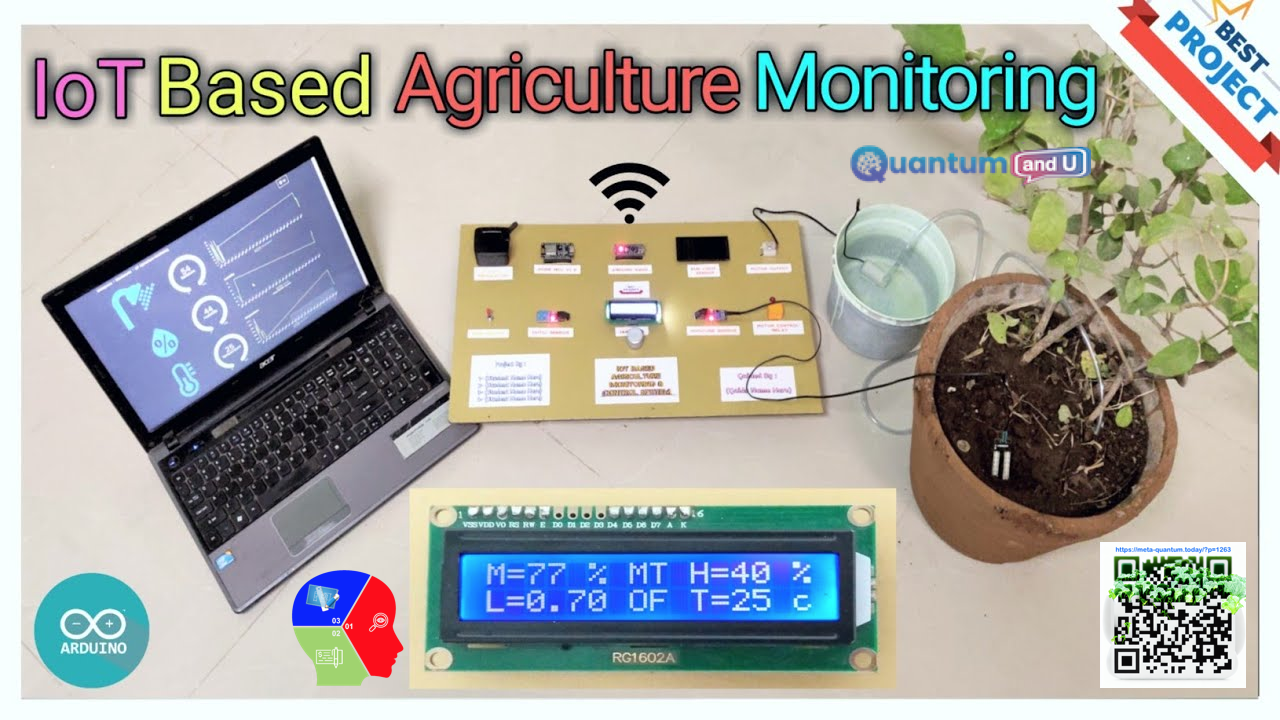
Introduction:
In this captivating YouTube video review, we will dive deep into the mesmerizing world of IoT-based agriculture monitoring systems. With the world’s population constantly increasing, agriculture has become more critical than ever before, and the integration of IoT technology can be a game-changer in optimizing crop management to ensure the quality and quantity of food. This video presents an in-depth analysis of the various components involved in setting up the IoT-based agriculture monitoring system. The video also gives practical insights into the testing and implementation of the system. It is an excellent resource for anyone interested in understanding the potential of IoT technology in agriculture. The video is a gateway to a world of endless possibilities where technology meets agriculture to help us feed a rapidly growing global population in a sustainable manner.
Market size for IoT based agriculture monitoring system:
The market size for IoT based agriculture monitoring system using Arduino & Node MCU in Southeast Asia is estimated to be $188 million in 2024. The market is expected to grow at a CAGR of 11.7% from 2020 to 2024.
The growth of the market is driven by the increasing demand for food, the need to improve agricultural productivity, and the rising adoption of IoT technology in the agriculture sector.
Arduino and Node MCU are two open-source platforms that are commonly used to develop IoT-based agriculture monitoring systems. These platforms are easy to use and affordable, making them a good fit for small and medium-sized farmers in Southeast Asia.
The IoT-based agriculture monitoring system using Arduino & Node MCU can collect data on various environmental factors such as temperature, humidity, soil moisture, and light intensity. This data can be used to monitor the health of crops and optimize their growth. The system can also be used to control irrigation and fertilization, which can help to improve crop yields.
The adoption of IoT-based agriculture monitoring systems is expected to increase in Southeast Asia in the coming years. This is due to the increasing demand for food, the need to improve agricultural productivity, and the rising adoption of IoT technology in the region.
Here are some of the factors that are driving the growth of the market:
- Increasing demand for food: The population of Southeast Asia is growing rapidly, and this is putting a strain on the region’s food supply. IoT-based agriculture monitoring systems can help to improve agricultural productivity and meet the growing demand for food.
- Need to improve agricultural productivity: The agricultural sector in Southeast Asia is still relatively inefficient. IoT-based agriculture monitoring systems can help to improve agricultural productivity by providing farmers with real-time data on their crops.
- Rising adoption of IoT technology: The adoption of IoT technology is growing rapidly in Southeast Asia. This is due to the increasing availability of low-cost IoT devices and the growing connectivity infrastructure in the region.
The following are some of the challenges that the market is facing:
- High cost of implementation: The initial cost of implementing an IoT-based agriculture monitoring system can be high. However, the long-term benefits of these systems can outweigh the initial costs.
- Lack of awareness: There is still a lack of awareness about the benefits of IoT-based agriculture monitoring systems among farmers in Southeast Asia. This is a major challenge that needs to be addressed in order to accelerate the adoption of these systems.
- Lack of skilled workforce: There is a lack of skilled workforce in Southeast Asia to develop and implement IoT-based agriculture monitoring systems. This is another challenge that needs to be addressed in order to grow the market.
Despite these challenges, the market for IoT based agriculture monitoring system using Arduino & Node MCU is expected to grow in Southeast Asia in the coming years. The increasing demand for food, the need to improve agricultural productivity, and the rising adoption of IoT technology in the region are the key factors driving the growth of the market.
Related Sections:
- Components of the IoT System:
- The main switch for system control.
- A 5-volt regulator for Arduino and sensors.
- The ESP8266 module for Wi-Fi connectivity.
- Arduino Nano as the system’s brain.
- A solar cell for light intensity sensing.
- AC connector for the water pump.
- A relay for water pump control.
- Soil moisture sensor for measuring soil water content.
- A variable resistor for LCD contrast.
- A 16×2 LCD for displaying data.
- DHT11 humidity and temperature sensor for weather conditions.
- Irrigation System Components:
- A DC submersible water pump.
- Pipes for water pump connection.
- A bucket for water supply.
- Soil moisture testing with different moisture levels.
- Accessing Project Data Online:
- Using Adafruit.io to monitor data remotely.
- Visualizing data through gauges, graphs, and symbols.
- Monitoring humidity, temperature, sunlight, and water pump status.
- Setting Up Wi-Fi Connectivity:
- Configuring the system to connect to a mobile hotspot.
- Adapting Wi-Fi settings in the Arduino code.
- Testing System Performance:
- Demonstrating soil moisture sensor and water pump operation.
- Ensuring the pump turns on below 20% moisture and off above 70%.
- Testing the sunlight sensor’s responsiveness.
- Verifying temperature and humidity readings.
Conclusion:
The video dissects an IoT-empowered agricultural surveillance system that optimizes crop management via a sensor network. This IoT constellation amasses pivotal field parameters such as temperature, humidity, light intensity, and soil moisture, empowering farmers to make data-informed decisions for crop refinement and yield augmentation. The system transcends mere data amassment; it leverages real-time data processing to maintain ideal soil moisture, ensuring water conservation and mitigating weather-induced detriments to crop health. Practical demonstrations in the video validate the system’s ability to gauge soil moisture precisely and modulate irrigation in line with it, bolstering sustainable farming and resource conservation. A salient attribute is remote supervision via Adafruit.io, enabling farmers to oversee their fields ubiquitously and perpetually. This characteristic augments agricultural operational efficiency and hastens responses to abrupt alterations, warding off potential crop devastation. In essence, this IoT-fueled agricultural system revolutionizes traditional farming, maximizing resources and enhancing yield. It positively influences sustainable farming methodologies and carries the potential to amplify agricultural productivity, positioning it as an auspicious future farming solution. The video adroitly portrays its proficiencies and prospective advantages to the agricultural sector.
Key Takeaway Points:
- IoT technology can significantly improve agriculture by providing real-time data on soil conditions and environmental factors.
- The system’s components, including Arduino Nano and ESP8266, work together to create an efficient monitoring solution.
- Remote data monitoring via Adafruit.io allows farmers to stay connected to their fields from anywhere.
- The system effectively controls the water pump based on soil moisture levels and responds to changes in light intensity.
References:


